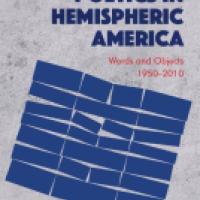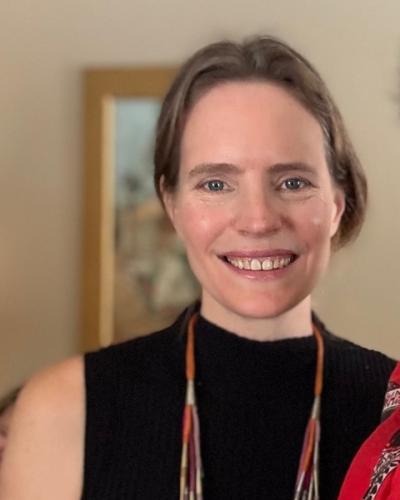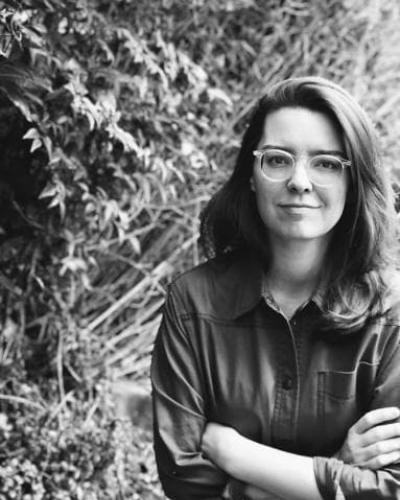In this new series, we highlight former Fellows’ monographs that grew out of their residency projects at the . This iteration of the Fellows' Q&A series features Rebecca Kosick, Senior Lecturer in Translation in the Department of Hispanic, Portuguese, and Latin American Studies at the University of Bristol (UK), and co-director of the the Bristol Poetry Institute, who was a 2014-15 "Sensation" Mellon Graduate Fellow. Her book, Material Poetics in Hemispheric America: Words and Objects 1950-2010, will be released September 30 from Edinburgh University Press.
Big Picture
The book asks, actually, a pretty simple question: what is poetry if we understand poetry to be an object? This project developed because I wanted to answer that question myself. I had come across this idea that the Noigandres group in 1950s São Paulo put forward in their “Pilot-Plan,” that “the concrete poem is an object in and of itself, not the interpreter of exterior objects and/or more or less subjective feelings.” (Here is a link to some of concrete poet Augusto de Campos’s work as an example). I was pretty much ready to accept this claim from the beginning, but I wanted to know what that meant, what it meant for poetry more broadly, for language, for communication, for art, and for objects.
This is changing now I think, but by the late twentieth century, concrete poetry and related forms had been basically written off in the U.S. In both poetry and the art world, lots of people dismissed these approaches as sort of quaint or obvious or—in a different direction—politically suspect. And the story of what poetry was, from the perspective of the United States, didn’t especially include these kinds of “experiments.” What I call “material poetry” (to encompass concrete, visual, and object-invested poetries) always had its defenders, but you can tell by the fact that they keep having to make the case for the form, that it’s been up against some resistance, or maybe more plainly, ignorance.
Book Cover Material Poetics.jpg
Alt Text
Material Poetics book coverBut the US is a hemispheric outlier in this regard. In Canada and in lots of countries throughout Latin America (the book focuses on Brazil and Chile), concrete, visual, and related poetries were much more high-profile. Part of my argument is that if you take a hemispheric view, material poetries occupy a much bigger branch of recent American poetry that it might seem to those who think American poetry ends at the US border.
As I was becoming interested in the object that is poetry there was, concurrently, a rising interest in objects in academic discourses. This was going on in the '90s in philosophy, but then made its way into a broader set of fields, including literary studies. What I found in material poetry was this very robust, philosophically-engaged exploration of the same sorts of questions about objecthood that other scholars were asking—but here poetry was the object in question. This was very exciting to me, and it helped me to deal with a problem I felt existed within literary adoptions of philosophies of the object, which was that literary scholars tended to talk more about objects in literature (things described or talked about in the text). I was interested in the actual poem or poetic object itself, which, in being language (albeit sometimes quite broadly understood language) is sort of complicating for some theories of objecthood that claim to speak for objects in general, but arose with objects other than poetry in mind.
In Particular
To my last point, there’s the issue of meaning, and by extension, humans. Some thinkers conceptualize words as objects by stripping away their meaning-making capacities. This has the effect of aligning words with other kinds of objects which can carry some kind of symbolic or meaningful function, but don’t have to, or don’t always. I think setting meaning aside makes it easier for us to understand words in the way that, for example, Graham Harman (who is associated with object-oriented ontology) understands objects, as not defined by their relations. But, for the poems I look at, even though they are overtly invested in poetic materiality and in being objects, meaning is in the picture. And, as a result, it becomes more difficult to disentangle these objects from the human-inflected relations they invite or instantiate.
This comes up in Brazilian concrete poetry as well as in the later, more intermedia group known as the neoconcretists. For the concrete poets, they wanted to resist language’s cooptation by discourse and raise the profile of words’ material features, so that when you read a concrete poem, you don’t immediately discard the substantive “container” of the word in order to get at the thing it represents. But that’s not quite the same as foreclosing meaning altogether. For neoconcretism, there is interest in the art or poetic object that, as Ferreira Gullar says, “in representing nothing, is its own representation.” But again here, while representation may be a target for critique, meaning itself is still present. And the neoconcretists were in fact very interested in relationality, and in meaning as something generated by humans’ sense experience of the object.
And the neoconcretists were in fact very interested in relationality, and in meaning as something generated by humans’ sense experience of the object.
Even poems that work to totally cut off the semantic aspects of language (which aren’t my priority in the book, but are part of the broader concrete or visual poetry movements) rely in part on a person being present for whom access to meaning is thwarted. So, if you take poetry as your exemplar object—even these kinds of poetry—I think you wind up with a different set of concerns than you do when other sorts of objects are in focus. I say this in the book but, a rock may go on being a rock whether we’re tossing it into a pond or not, but I’m actually not convinced that a poem is a poem with absolutely no relationship to some kind of differentiated human subject. I try to think through this prospect generously and go through a number of examples for how the poetries I look at reinscribe object and subjecthood, but humans are still, in the end, there.
Discovery
When this project started, I was translating a series of narrow prose poems and had some questions about their visual imprint on the page. I thought I would do some background research into concrete poetry, and, well, I thought it was background research anyway! Turned out to be more like foreground research. I’m probably supposed to paste over my enthusiasm with some cool critical distance, but: I really love material poetry. I was a poet before I came to this project, and the benefits of thinking through these questions—about what counts as poetry, what language is and is for, how poetry defines objecthood—have accrued for me in all sorts of ways beyond scholarship. I’ve worked on my own object-based poems, but in my more lyrical writing, too, have learned a lot from material poetics about what sound can do and how it means. I love teaching these works too, which ask students to leave behind a lot of what they take for granted about poetry and start to redefine the genre from the poems, up. In my academic life, I’ve also become even more sort of obstinately indisciplinary, if that’s not an oxymoron.
Fellowship
I was a Mellon Graduate fellow at the Society that year, so while I was there, this book wasn’t even yet a finished dissertation. Being one of two graduate students in a room full of more advanced academics was a major learning experience in itself, and it helped me to see how scholars from such a range of fields talked to one another across or through their sometimes distinct disciplinary footholds. As a graduate student, I think we are often most immediately concerned with proving that we know enough—about our own area, about our topic, our objects of study—and maybe less sensitive to the question of the “wider audience.” Working on my dissertation at the Society with these other scholars very quickly made the question of audience real to me. I was kind of productively forced to think about what advantages for thought my project offered to readers beyond my immediate area. Not just in the abstract sense, but for these people in the room with me.
Many of the conversations I had at the Society also pushed me to examine aspects of this project that were more nascent at the time. For example, that year prompted further work for me on the political implications of sensation-invested poetry (and art). This was particularly the case for my work on the neoconcrete group which was active in the immediately pre-dictatorship years in Brazil. Some of these reflections are incorporated into the book, but I also have two other recent publications (in Latin American Culture and the Limits of the Human and in College Literature, vol. 46 no. 1) that grew directly out of ideas that first sparked for me during our weekly seminars at the Society. It’s hard to overstate the impact of my year there for my work in the longer term, especially coming as it did at the end of my dissertation writing, and at the beginning of the career that grew from there.







